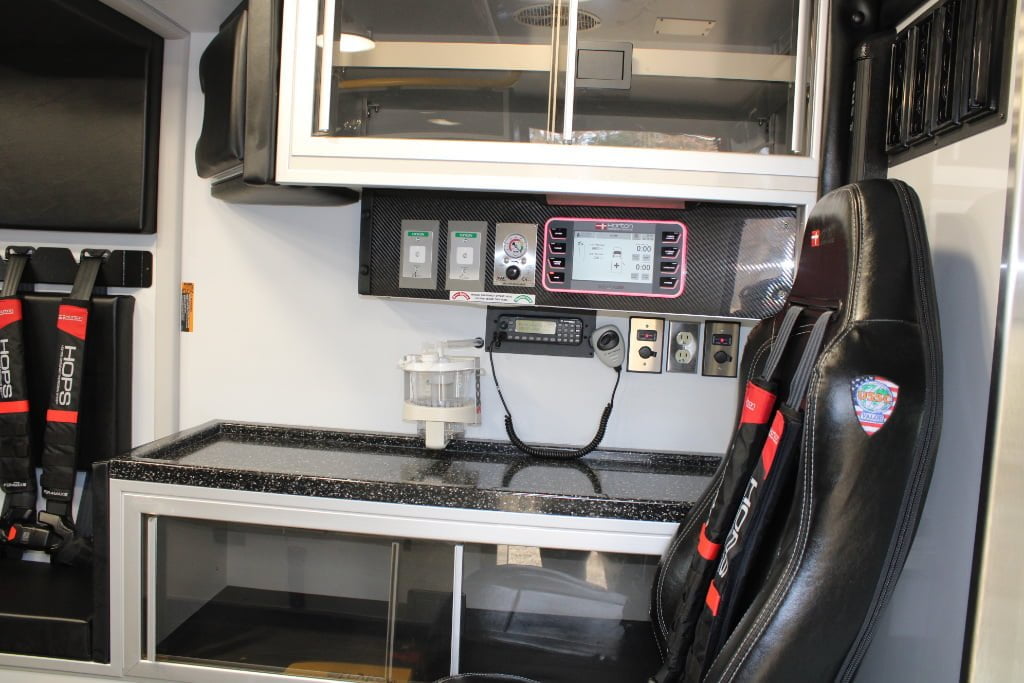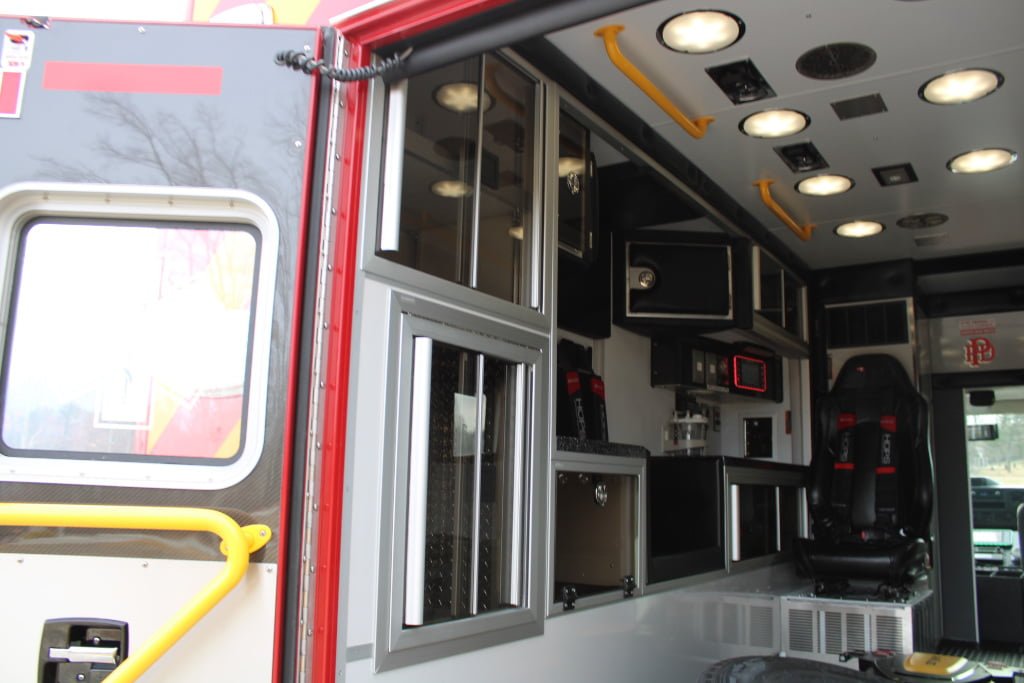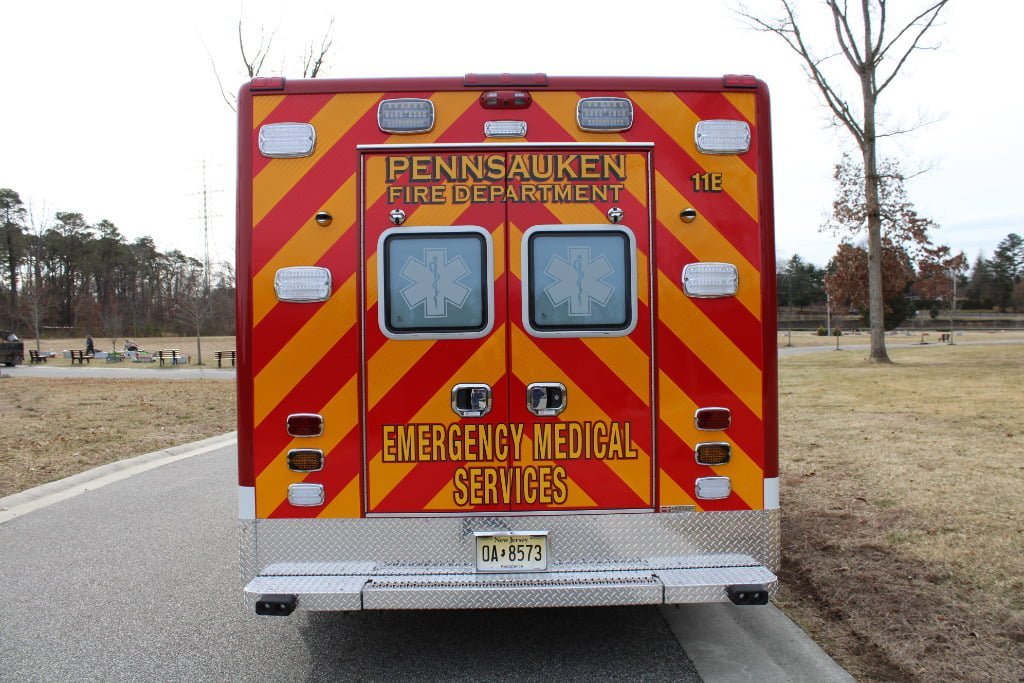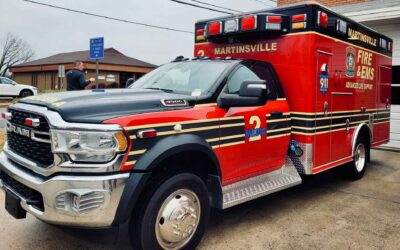
Horton Emergency Vehicles built this Type 3 ambulance for Pennsauken (NJ) Township Fire Department on a Ford E450 chassis with a 157-inch walk-through cab/module and 72 inches of headroom. (Photos courtesy of VCI Emergency Vehicle Specialists.)
By Alan M. Petrillo
When Pennsauken (NJ) Township Fire Department needed to replace one of its five ambulances, it turned to the manufacturer that had designed and built all of its current fleet — REV Ambulance Group’s Horton Emergency Vehicles — to produce a new Type 3 ambulance on a Ford E-450 chassis.

The Pennsauken Type 3 has Whelen M series warning and scene lighting, and rolled ICC LED marker lights at the upper corners of the roof radius.
Ed Paul, Pennsauken’s captain, says the department provides emergency medical services to a community of 12-1/2-square miles with a resident base of 38,000. “We run two BLS (basic life support) units 24 hours a day in two shifts,” Paul points out, “as well as a Power Truck from 7 a.m. to 7 p.m. Monday through Friday. In 2021, we ran an all-time high of 7,500 calls, which was driven a lot by the COVID-19 pandemic.”

The CPR seat is protected by REV Ambulance Groups Per4max four-point harness system.
Pennsauken had taken delivery of a Horton Type 3 ambulance last September, and this latest rig in February of this year. “We made some changes to the design of the most recent Horton Type 3,” Paul says. “We made a color change on the rig, added a CPR seat, a second O2 hookup on the ceiling instead of on the curb side of the patient, a carbon monoxide (CO) detector in the patient module, and a Stryker Power LOAD system and Power PRO XT cot.”

The Black Sierra USSC high-back bucket attendant’s seat has an integral child safety seat and is protected by a Per4max four-point harness.
Dave Marshall, director of sales for Horton Emergency Vehicles, says the Pennsauken rig is built on a 2022 Ford E-450 chassis with a 157-inch walk-through cab/module with headroom of 72 inches. The ambulance is powered by a 7.3-liter gasoline engine, has entry door thresholds covered with Line-X, and has a custom pull-out battery tray for a two battery system.

The module’s ceiling has seven Whelen LED interior dome lights. (Note that the seventh light is not visible in the lower right corner of the photo.)
Marshall notes that the Type 3’s patient module has a Black Sierra USSC high-back bucket attendant’s seat with an integral child safety seat, a CPR seat on the street side of the module, and a double-place squad bench. All seating locations are protected by the Per4max four-point seatbelt system, he adds, while the attendant’s seat is protected by head curtain and tubular airbags, and the CPR and squad bench seats by tubular airbags. The rig also is fitted with the Horton Occupant Protection System (HOPS) and the COOLTECH II heating, ventilating and air conditioning system with a 100,000-BTU (British Thermal Unit) compressor.

The driver’s console on the Pennsauken Type 3.
David DiGangi, regional sales manager for VCI Emergency Vehicle Specialists, who sold the Type 3 to Pennsauken, says the ambulance has aluminum wheels with painted center hubs, a three-inch drop skirt on the curb side which allows for a double step, making it easier for patient entry, electronic privacy glass activated by the press of a button to make the windows opaque, and solid surface Corian® counter tops, with all cabinet trim radiused.

The Pennsauken Type 3 is equipped with electronic privacy glass that can be made opaque at the touch of a button.
DiGangi says the interiors of the access doors are covered with black carbon fiber panels which are extremely wear resistant, grab rails at the doors and on the ceiling are safety yellow microbial bars, the squad bench cabinet has a hinged custom glove storage area, the ambulance is fitted with electric door locks for the exterior compartments, and the rig has an oxygen transfill system with a 10-foot stainless steel hose that allows the rig to pull up next to a cascade system and fill the O2 bottle without removing it from the truck.

Pennsauken had Horton build an interior/exterior access at the top of the rear compartment on the driver’s side.
Pennsauken’s Type 3 Horton ambulance has Whelen M series exterior warning lighting, Whelen M series scene lighting, rolled ICC LED marker lights at the upper corners of the roof radius, seven Whelen LED interior dome lights, a Horton 360-degree camera system, and a Horton security idle system that allows the medics to keep the truck running and locked on a scene, but still run either the heating or air conditioning system, depending on the season.

The rig has an oxygen transfill system with a 10-foot stainless steel hose that allows the ambulance to pull up next to a cascade system and fill the O2 bottle without removing it from the truck.
ALAN M. PETRILLO is a Tucson, Ariz.-based journalist, the author of three novels and five non-fiction books, and a member of the Fire Apparatus & Emergency Equipment editorial advisory board. He served 22 years with Verdoy (NY) Fire Department, including the position of chief.




